

How To Write Music Using Song Keys - Tips To Improve Your Songwriting. How To Write Music Using Song Keys Confused about song keys?

Have you heard someone say a song was "In the key of C" and not known what they were talking about? You're not alone; a lot of beginner songwriting struggle to come to grips with song keys when they're learning how to write songs. It can be a complicated subject but if you just get your head around the basics you'll be doing great, and who knows what possibilities it will "unlock" in your songwriting. What Is The "Key Of A Song? " Music Theory for Songwriters - Part 9. Phrygian dominant scale. Traditional use[edit] The scale is very common in Middle Eastern music, particularly Arabic and Egyptian music.
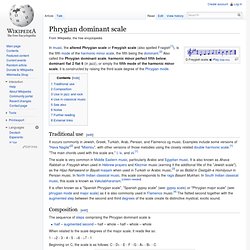
It is also known as Ahava Rabbah or Freygish when used in Hebrew prayers and Klezmer music (earning it the additional title of the "Jewish scale"), as the Hijaz-Nahawand or Bayati maqam when used in Turkish or Arabic music,[3] or as Bidād in Dastgāh-e Homāyoun in Persian music. In North Indian classical music, this scale corresponds to the raga Basant Mukhari. In South Indian classical music, this scale is known as Vakulabharanam. [citation needed] Tritone. In classical music, the tritone is a harmonic and melodic dissonance and is important in the study of musical harmony.

The tritone can be used to avoid traditional tonality: "Any tendency for a tonality to emerge may be avoided by introducing a note three whole tones distant from the key note of that tonality. "[3] Contrarily, the tritone found in the dominant seventh chord helps establish the tonality of a composition. These contrasting uses exhibit the flexibility, ubiquity, and distinctness of the tritone in music. Augmented fourth and diminished fifth[edit] Full ascending and descending chromatic scale on C, with tritone above each pitch. Any augmented fourth can be decomposed into three whole tones. B–C (minor second), C–D (major second), D–E (major second), and E–F (minor second).
Rhythm Guitar. Part 1- Powerchords. In the first installment of rock rhythm guitar you will learn about power chords.
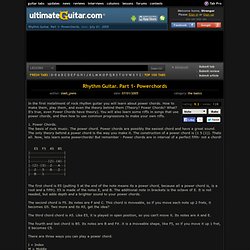
How to make them, play them, and even the theory behind them (Theory? Power Chords? Byzantine music. Byzantine music (Modern Greek: Βυζαντινή μουσική) is the music of the Byzantine Empire composed to Greek texts as ceremonial, festival, or church music.[1] Greek and foreign historians agree that the ecclesiastical tones and in general the whole system of Byzantine music is closely related to the ancient Greek system.[2] It remains the oldest genre of extant music, of which the manner of performance and (with increasing accuracy from the 5th century onwards) the names of the composers, and sometimes the particulars of each musical work's circumstances, are known.

Extent of Byzantine music culture vs. liturgical chant proper[edit] The term Byzantine music is commonly associated with the medieval sacred chant of Christian Churches following the Constantinopolitan Rite. The identification of "Byzantine music" with "Eastern Christian liturgical chant" is a misconception due to historical cultural reasons. Today, few sources and studies exist about Byzantine music on the whole. Gloria Morti - Anthems of Annihilation. UG Community @ Ultimate-Guitar.Com - Tremolo Picking Exercises... I´d recommend you learned the Master Of Puppets solo (or just the end of it), Beat It [EVH] solo (or again, just the end), One solo, Tornado Of Souls solo (slower, of course, if you´re new to this you won´t be able to play it at original tempo), the Intro to Phantom of the Opera, and some Van Halen solos (EVH used tremolo picking A LOT) I´d say Hot For Teacher.
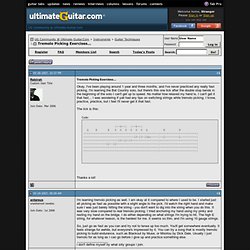
These songs have some real good picking sections, I hope this helps you out. Also I URGE you to buy small, thick picks. You are a lot less clumsy and don´t have to force as much (like mrcoldhell said). I´d reccomend Tortex 1.0 mm small picks: Jazz III max-grip small picks: Or my personal favorites, Dunlop Stubby 1.0 mm picks: Hope this helps, and dude, please, A7X? Later! Thor - Thunder On The Tundra [Studio Version] Meet My Friend Mr. Tritone. Tremolo Picking Tips? @ Ultimate-Guitar.Com Forum Archive. View Full Version : Tremolo Picking Tips?
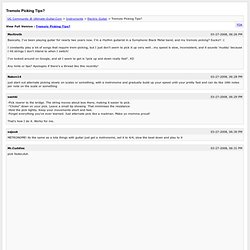
Mortiroth Basically, I've been playing guitar for nearly two years now. I'm a rhythm guitarist in a Symphonic Black Metal band, and my tremolo picking? Sucks!! :( I constantly play a lot of songs that require trem-picking, but I just don't seem to pick it up very well...my speed is slow, inconsistent, and it sounds 'muddy' because I hit strings I don't intend to when I switch! Guitar/Tremolo Picking. What is Tremolo Picking?
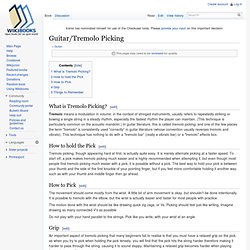
[edit] Tremolo means a modulation in volume; in the context of stringed instruments, usually refers to repeatedly striking or bowing a single string in a steady rhythm, especially the fastest rhythm the player can maintain. (This technique is particularly common on the acoustic mandolin.) Just Chords: Three-Note-Chord Specials. What's left for now?

There are some topics we already touched. But we have to do this is detail now. So we get a collection of single things also interesting for all chords. Chord inversions If we take a chord this has now three notes, e.g. But the sound of a chord really changes with the sequence, so there is a name for this: chord inversion. The basic form of a chord is: 1 - 3 - 5, which means that the root note is the lowest note. Guitar/Alternate Picking. Alternate picking is an important skill, because it allows you to play more than twice as fast than with just down picking.

The basic idea is that if you are picking just on down strokes, every time you bring the pick back up to stroke down again, you are missing an opportunity to hit the string again. Essentially alternate picking is more efficient, because you have to move you hand less distance to hit the next note, and it can be an important difference between hitting the note on time or struggling to reach it. As with other guitar skills, it doesn't sound even a little difficult until you actually try and do it.
It will take some time to master it and get really fast. After doing it for a long time, you will begin to notice that you are subconsciously deciding whether to alternate pick or not, depending on the underlying rhythm. Hold the pick in whichever method feels best for you. Lesson 1[edit] Play this pattern up and down the strings, and then up and down the whole neck.